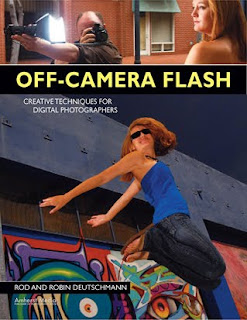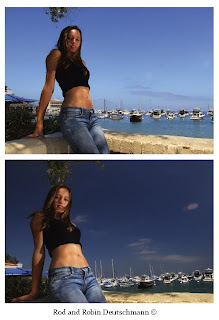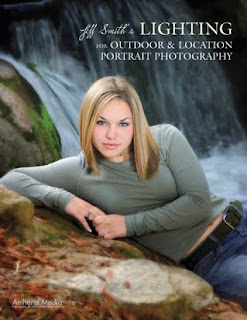 Today's post is an excerpt from the book Photographic Lighting Equipment: A Comprehensive Guide for Digital Photographers by Kirk Tuck. It is available from Amazon.com and other fine retailers.
Today's post is an excerpt from the book Photographic Lighting Equipment: A Comprehensive Guide for Digital Photographers by Kirk Tuck. It is available from Amazon.com and other fine retailers.This section is focused on the accessory reflectors that are available for many of the studio flash heads and monolights on the market. (Most movie lights—and hot lights in general—already incorporate their own reflectors, and fluorescent light units are mostly used with softboxes and umbrellas or they have their own built-in reflectors.) Part of the appeal of these lighting systems is that they are flexible and adaptable. There are specialized reflectors for many different applications. These interchangeable reflectors can radically change the character of the light coming from the business end of your studio flash!
The electronic flash head is like a blank canvas for photographers. The most flexible systems allow us to choose the reflectors we need to best do the shot in front of us right now. I own Profoto, so I’m going to use their reflectors as examples, but nearly all of the flash manufacturers offer a good range of metal reflectors that are made to modify the light from the flash tubes in a certain way.
 Different reflectors have different properties. The rule of thumb is that a bigger reflector yields a softer light. This is true most of the time, but the internal finish of the reflector and its shape also have a lot to do with the quality of light they reflect.
Different reflectors have different properties. The rule of thumb is that a bigger reflector yields a softer light. This is true most of the time, but the internal finish of the reflector and its shape also have a lot to do with the quality of light they reflect. Umbrella Reflectors. These are also called “spill kill” reflectors. These modifiers have a small diameter lip that keeps light from the flash tubes from spilling back toward the camera. A bare flash sends light in all directions, and although the body of the flash head or monolight blocks some light, you’ll need an umbrella reflector if you want to keep the photons corralled into the front 180 degrees of your flash head. While the Profoto reflector (like all the light modifiers for the system) can be “zoomed” forward or backward to narrow or widen the beam, we mostly use them in a position that fills our umbrella with light and blocks any extra light from spilling around the edges. I call it “tuning the reflector” to the umbrella. Other manufacturers design their spill kills so that they work well for most umbrellas. Even the simplest and least expensive
ones from budget flash makers like AlienBees work well in its intended use.
I wouldn’t use an umbrella reflector by itself as the light would be too uncontrollable.
 Top—Part of the charm of a well-designed system is the range of looks you can get with the combination of a good modifier system. Note the numbers on the side of the monolight shown here. The head can be slid forward or backward along the body of the flash to change the angle of dispersion for the flash. This allows you greater control when “tuning” the reflector and head for use with an umbrella or softbox. Bottom—Profoto 600 watt-second monolight with an umbrella reflector. The umbrella reflector can also be used in situations where you need a hard, almost barebulb effect, but with greater efficiency.
Top—Part of the charm of a well-designed system is the range of looks you can get with the combination of a good modifier system. Note the numbers on the side of the monolight shown here. The head can be slid forward or backward along the body of the flash to change the angle of dispersion for the flash. This allows you greater control when “tuning” the reflector and head for use with an umbrella or softbox. Bottom—Profoto 600 watt-second monolight with an umbrella reflector. The umbrella reflector can also be used in situations where you need a hard, almost barebulb effect, but with greater efficiency. Standard Reflectors. As the name implies, these are the all-purpose reflectors that usually come with the flash head or monolight. They are usually 7 to 9 inches in diameter and restrict the beam from the flash tube to somewhere between 90 and 120 degrees. They provide enough light control so if you bounce your flash from the ceiling, no direct light will strike your subjects. They are useful when you need to bounce your flash off a ceiling, a wall, or a big hunk of foam core. They can also be used as a decent substitute for an umbrella reflector. Usually, the interior surface is a pebbled metallic finish or a silver matte finish, as manufacturers try to steer a middle course between light efficiency and softness. Standard reflectors are also available with a highly polished interior for use with grids. Keep your standard reflectors handy. You will always find a use for them.
 This is the standard AlienBees monolight package with the included standard reflector. Note the two “ears” sticking up near the top. These are spring-loaded levers that hold accessories in place.
This is the standard AlienBees monolight package with the included standard reflector. Note the two “ears” sticking up near the top. These are spring-loaded levers that hold accessories in place. Profoto lights offer an excellent selection of modifiers. This is their standard reflector, and it takes full advantage of the head design, which allows modifiers to be “zoomed” backward or forward on the body of the flash head or monolight. This allows one reflector to have a tighter or broader light pattern.
Profoto lights offer an excellent selection of modifiers. This is their standard reflector, and it takes full advantage of the head design, which allows modifiers to be “zoomed” backward or forward on the body of the flash head or monolight. This allows one reflector to have a tighter or broader light pattern. Magnum Reflectors. Every flash line seems to include one of these reflectors. Bigger than the standard reflector by at least a factor of two and a bit smaller than a beauty dish reflector, these allow for an output that is midway between the contrasty light of the smaller units and the very soft light of umbrellas and softboxes. Photographers who swear by these units use them because the bigger bowl and the wider diameter gives them more control when they want to use the edge or penumbra of the light. (The edge of the light can be softer and more interesting than the middle of the beam.) Master portrait lighters like to put a light over to the side and then rotate it so the main beam moves in front of the subject. At some point, they will see the penumbra effect and they’ll know they’ve got the light right where they want it. I try to do that, but it is hit and miss for me, so I use the Magnum reflector to produce a nice, even source of direct light on a background plane or as the “delivery option” when pushing an even light through a diffuser or scrim. It has a softer character than the standard reflector, but it will still give your light some edge when used correctly.
 This is the front of a Profoto Magnum reflector. It is about 13 inches in diameter and does a good job of throwing a compact circle of light, which is slightly softer than the standard reflector.
This is the front of a Profoto Magnum reflector. It is about 13 inches in diameter and does a good job of throwing a compact circle of light, which is slightly softer than the standard reflector.  This is a reflector size that seems lost in the middle region of lighting accessories—it is too big to be a hard light source but too small to be really soft for portrait work. Really, it is a very useful modifier that gives a good tonal rendering with snappy edges. Used in expert hands, it can be a very beautiful main light for dramatic portraits.
This is a reflector size that seems lost in the middle region of lighting accessories—it is too big to be a hard light source but too small to be really soft for portrait work. Really, it is a very useful modifier that gives a good tonal rendering with snappy edges. Used in expert hands, it can be a very beautiful main light for dramatic portraits. Beauty Dishes. A beauty dish is a large flat dish reflector in the range of 16 to 30 inches in diameter. Most have a white painted interior to reduce specularity and soften the light. Nearly all of them have a little panel that “floats” over the flash tube so that no direct light is emitted from the reflector. All illumination comes from the white bowl. One specialty manufacturer even makes a 40-inch version, but the price is outrageous. So, here’s the gist of the argument: I understand that the beauty dish is meant to be used close to a model’s face; my fashion photographer friends even have a formula that says beauty dishes should be used at a distance equal to about 2x the diameter of the beauty dish. That’s about 32 to 60 inches from the subject. What I’m supposed to see is “a soft, smooth light with crisp (but not hard) shadows that quickly falls off on the edges.” I’ve owned a beauty dish for years, and I just don’t see much of a difference between it and a well-tuned umbrella of the same basic size. But take this with a grain of salt. I’m not a professional beauty photographer, and I admit that they’re probably more sensitive to the nuances of their specialty. My biggest reason for choosing a small, black backed umbrella over the beauty dish is the difference between $22 (a little umbrella) and $300 (the cool beauty dish). My portraiture style usually calls for a much bigger and softer light source like a 60-inch umbrella or a big softbox.

The design of a typical beauty dish seeks to collimate the light from a flash into a controlled but soft beam of light that falls off more at the edges than light from an umbrella or a typicalparabolic reflector. Most beauty dishes are 16 to 30 inches in diameter and have a center reflector plate that keeps direct light from the lamp or flash tube from hitting the subject. The beauty dish evolved back in the late 1950s when glamour photographers were seeking a softer look from the very bright hot lights in use with the slow films of the day. The well-designed beauty dish has a look all of its own, and they continue to be popular with modern portrait photographers.
Play with a beauty dish. You might find it irreplaceable. Then again, you might find it about as useful as a 20- or 32-inch umbrella. With all light modifiers, so much is subjective and dependent on your style. That’s my two cents’ worth.
 Left—A rear view of the AlienBees beauty dish gives you some idea of its relative size. Many location photographers are replacing their umbrellas and softboxes with beauty dishes because they are more stable in the wind. One problem with beauty dishes is that you can’t tilt them down very far when they are attached to a conventional light stand. Right—This is a side view of a beauty dish on an AlienBees monolight. The beauty dishes range from simple to elegant, but all do the same job: they throw crisp light on a close by subject while hastening the falloff on the edges.
Left—A rear view of the AlienBees beauty dish gives you some idea of its relative size. Many location photographers are replacing their umbrellas and softboxes with beauty dishes because they are more stable in the wind. One problem with beauty dishes is that you can’t tilt them down very far when they are attached to a conventional light stand. Right—This is a side view of a beauty dish on an AlienBees monolight. The beauty dishes range from simple to elegant, but all do the same job: they throw crisp light on a close by subject while hastening the falloff on the edges. Telephoto Reflectors. Some companies offer longer, narrower reflectors that are meant to throw a beam of light a long distance by concentrating it into a narrower pattern. These are usually marketed to sports photographers who are trying to get some light on an athlete at a distance. I’ve never felt the need for one, so I can only assume they do what they’re designed to do, and if you have a burning need to light something 50 feet away you’ll want to look into them. At least you now know that they exist.
All of the above reflectors are standards in most well-equipped equipment lines. There are lots more to choose from, but you needn’t own every article in a manufacturer’s catalog to do great work. My research tells me that most of my peers use one or two reflectors year after year and supplement those with one or two favorite attachable light modifiers.
BUY THIS BOOK FROM AMAZON































